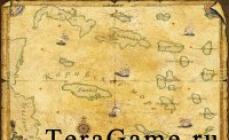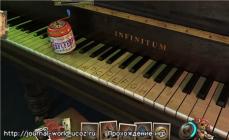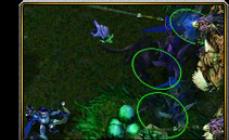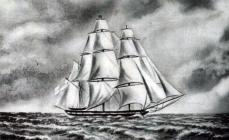I Believe, We Will Meet the 100th Anniversary (Y. Bondi, 1920)
On February 23 (n. Art.) 1918, the SNK proclamation of February 21 “The Socialist Fatherland is in Danger” was published, as well as the “Appeal of the Military Commander-in-Chief” N. Krylenko, which ended with the words: “<…>All to arms. All to defend the revolution. All-round mobilization for digging trenches and the expulsion of trench detachments is entrusted to the Soviets, with the appointment of responsible commissars with unlimited powers for each detachment. This order is sent as instructions to all councils in all cities. " Subsequently, a myth was invented about the victory won that day over the Germans near Pskov and Narva. This is how the Civil War began.
The White movement was defeated not only on the battlefields. Whites suffered a crushing defeat on the propaganda front as well. For propaganda, it is absolutely not important whether the information on the poster or leaflet corresponds to reality (however, you should not go too far with inaccurate information). Only one thing is important - a leaflet, a poster, a newspaper should be believed by the "target audience". And how it really is there - it doesn't matter. White propagandists could offer their audience elections to the Constituent Assembly and United Russia (the party of the same name did not exist yet, but the slogan already existed). The Reds offered: land to the peasants, factories to the workers, and peace to the peoples. And who won in the end? And the notorious terror was red, white, green, and simply terror without political slogans. A civil war cannot do without "excesses".
And we offer you a selection of propaganda posters of those years, both red and white.
Red posters.
Poster with Trotsky "Be on guard"
A very unusual poster - a Jew, a Bolshevik and a fighter with the church Trotsky in the role of the Christian Saint George the Victorious.
Join the ranks of the police. 1920
We won't give up Petrograd! (D. Moore, 1919)
What gave October Revolution working people (1919)
Did you sign up as a volunteer? (D. Moore, 1920)
Wrangel is coming! (N. Kochergin, 1920)
White Posters
Why aren't you in the army? (1918?)
Per united Russia (1919)
Happy Worker in the Council of Deputies (1919)
Your family and friends are groaning under the yoke of the Bolshevik commissars, they are dying of violence and hunger, they are calling you. Go save them! (1919)
What Bolshevism brings to the people (1918)
My Russian friends! I, an Englishman, in the name of our common allied cause, I ask you: hold out for a little longer as fellows as you have always been. I have delivered and will deliver without limit anything that you need, and, most importantly, I will deliver you a new weapon that will exterminate these hideous, bloodthirsty red monsters.
The Motherland is calling.
The Soviet social poster is a very ambiguous and multifaceted phenomenon, its content changed in accordance with the main milestones of the socialist past. Therefore, when considering this topic, it becomes necessary to divide the long Soviet period into time periods. Below are the works of Zaltsman and Kustodiev in 1917.



In the first years after the Revolution, when the country was in ruin and decline, the main task of the Bolsheviks was to instill in newly minted Soviet citizens a new system of values, drawing a hard line between them and the citizens of Western countries, who were squeamishly called "bourgeoisie". Therefore, contrast becomes a characteristic technique in the works of many poster artists. Of course, the bourgeois was portrayed grotesquely - all possible shortcomings were exaggerated. Such are, for example, the posters of the artist Denis "Capital" and "Comrade. Lenin cleans the earth of evil spirits. " If the caricature of a flabby gentleman sitting on a pile of gold still does not raise questions, then turning to the topic evil spirits in the second work, it is perplexing. The disproportionate image of Lenin gives the impression that he is flying on a broomstick. I wonder if the poster had any idea of this funny effect.

.jpg)
The encouragement of workers is another common theme of this period. At the same time, a large array of social posters was dedicated to the condemnation of bad habits and irresponsible attitude to work. Universal education was also promoted, with particular emphasis on educating women. Characteristic is the work of the artist Iznar "Woman, literacy is the guarantee of your emancipation" 1920

The work of Kudryashov in 1920


Mayakovsky 1920
During the Civil War, Soviet poster artists tried to support the Red Army with appropriate work. Denis's poster "On the grave of counterrevolution" in 1920 is notable.
.jpg)
.jpg)

Separately, it is worth dwelling on Moor's work "Help" in 1921, dedicated to the famine in the Volga region. The image of an emaciated figure with arms outstretched against a plain black background is impressive. The emotional image didn't even need additional details, except for a thin spikelet behind the figure.

Another poster on this topic is Simaov's work "Remember the Hungry" in 1921.

New types of Soviet citizens were also widely reflected in posters: workers (both men and women) were painted in characteristic clothing and with appropriate attributes: a hammer, a scythe, red scarves, overalls, and so on. With their posters, the artists tried to stop, discourage the viewer, instill in him a certain way of thinking.
.jpg)




A political poster as a type of printed art graphics - a large, bright, symbolic image, with a short text, made for agitation, propaganda, advertising or educational purposes, is known in Europe since late XIX v. In Russia, posters appeared at the turn of the 19th and 20th centuries.
The stylistics and imagery of the popular prints and the spectacular posters were the basis for the artistic solutions of the Russian political poster, which arose and formed during the First World War of 1914-1918. and the revolutionary events of 1917
A revolutionary time always presupposes the active involvement of the broad masses in political life countries, motivation in the minds and hearts of people of an emotional response to current events. Propaganda printed graphics affect the mind of the viewer by artistic techniques and allows you to achieve this response.
The February Revolution of 1917 was enthusiastically received in Russia as the beginning of a new era in the history of the country. All political forces in the country understood the importance of artistic agitation and propaganda in the battle for the minds of compatriots.
The first Russian political posters are an invaluable historical and artistic source. They reflect the course of events in 1917 in the country, as well as the origin and formation of the main genre and stylistic features of the art of Russian poster, in which the first attempts were made to generalize the types and images of the era presented to the viewer for admiration or anger.
Satirical poster
Since ancient times, humor has given people strength and helped in difficult trials. The most popular component of laughter culture is caricature. Therefore, in times of serious internal and external upheavals, it becomes one of the main instruments of propaganda and special attention is paid to it. During the revolutionary events of 1917, satire became a means of mass agitation, the main direction of which was to discredit the representatives of the overthrown monarchical system - the tsar, his entourage, ministers and senior officials.
The first revolutionary popular prints were published in March 1917 by the Parus publishing house in Petrograd. To create luboks with satire on the collapsed formation, Vladimir Mayakovsky, who had previously gained fame as the author of several bright war pictures published by the Segodnyashny Lubok publishing house, and the popular cartoonist Alexei Radakov were invited. Their works became a kind of forerunners of "ROSTA Windows".
Propaganda poster
Until October 1917, representatives of almost all political movements declared the need to continue the war until victory and loyalty to Russia's allied obligations. The government needed cash contributions from the population to finance the fighting. The pre-revolutionary War Loan has now become the Freedom Loan.
In August 1917, a special meeting under the Provisional Government published the Regulations on elections to the Constituent Assembly - the body of power that was supposed to decide the fate of the state structure of Russia. The first general election campaign in the history of Russia began - a fierce and uncompromising struggle for votes Russian people... Several dozen parties and associations, both political and national, took part in the elections. The largest of them were the parties of socialist revolutionaries, social democrats (Bolsheviks and United), constitutional democrats (Party of People's Freedom). The campaign posters of these parties are the forerunner of the internationally recognized "brand" - the Soviet political poster.
The last poster dedicated to the Constituent Assembly was published at the end of 1917. It called on citizens to come out to a demonstration in defense of the legally elected authority. Its first meeting, which took place on January 5 (18), was also its last.
Information poster
The poster, as one of the main means of communication, bears an informative function, informing about the cardinal changes in the country. The abdication of Nicholas II from the throne on March 2 (15), 1917 and the formation of the Provisional Government marked a new page in the history of Russia. In connection with the traditional personification of historical events and the need to popularize new persons in power, portraits of the leaders of the revolution began to be published.
Great importance was also given to the artistic embodiment on paper of popular sentiments during the period of the great turning point. So the Moscow printing house of the I.D. Sytina released a series dedicated to the days of the February Revolution in the regions of the country.
Another important type of agitation used by the Bolsheviks in early years is a poster campaign. The role of the poster is especially great in the years civil war... We can say that in those conditions, posters replaced the lack of newspapers. The poster is visual, understandable even for an illiterate person.
The importance the Bolsheviks attached to poster agitation is evidenced by the fact that the transportation of political agitation posters was equated with the delivery of urgent military supplies. It was forbidden to tear down or spoil posters with political content.
From the article by N. Chaus "Soviet posters of 1917-1920. the main means of promoting socialist ideology ":
“It is strictly forbidden to rip and stick up the poster - the guilty will be brought to justice,” was printed on many posters. "Anyone who rips off this poster or sticks it up with a poster is committing a counterrevolutionary deed." That was the stern warning that was printed during the civil war on political posters pasted on the walls of houses, on fences, on the carriages of trains going to the front.
B1917 - 1920s propaganda teams () practice such a form of work as a poster exhibition.

Agitation train car
In the 1920s. campaign posters are beginning to be actively used as a social advertisement: the fight for universal literacy, health (fight against tuberculosis, drunkenness, improper childcare), women's equality, the fight against homelessness, etc.


Orphanage, 1920
E. E. Lezhen in the article "A poster as a means of political agitation in the 1917-1930s" writes:
Most of the pre-revolutionary artists began to collaborate with the Soviet regime. Among them were itinerants, and Russian impressionists(A.A. Rylov, K.F. Yuon), and world of art(E.E. Lansere, M.V.Dobuzhinsky), and members of the association "Blue Rose"(P.V. Kuznetsov, M.S. Saryan), and supporters Jack of Diamonds(P.P. Konchalovsky, I.I.Mashkov, A.V. Lentulov). At first, a special place in the department of fine arts of the People's Commissariat for Education was taken by abstractionists V.V. Kandinsky and K.S. Malevich.
The revolution gave birth to new directions. Russian revolutionary avant-garde "Unovis"("Approvers of the New Art", 1919 - 1920: KS Malevich, MZ Chagall, LM Lisitsky) declared a struggle for "pure" art and began to develop agitation forms. "KNIFE" ("New Society of Painters") was close to the Diamonds of Diamonds. Proletcult made an attempt to create an organization of a new proletarian culture "on the ruins of the past", rejecting the classical heritage, but did not last long.

Moore, Red Gift, 1920. The painting shows: House of mother and child,Council of Workers 'and Peasants' Deputies, Kindergarten, School for adults, Library, Workers' Club
In the 1919s, the so-called "ROST windows":
In the post-revolutionary years, V. Mayakovsky contributed to the organization of the so-called "ROST Windows" (Russian Telegraph Agency), in which M.M. Cheremnykh and D.S. Moore. At that time, artists were involved in the creation of propaganda materials that could be understood by the illiterate population. The posters were displayed by the telegraph agency in the windows of the first floor, hence the name of the organization - "ROST Windows".

V.V. Mayakovsky. A poster about electrification for ROSTA Windows. December 1920

V.V. Mayakovsky. "Every truancy is a joy to the enemy ..." 1921
Art critic Tatyana Sergeevna Igorshina writes:
For poster works of the first revolutionary decades, avant-garde compositional-graphic and stylistic techniques were characteristic. This is the active use of photomontage in the image, complemented by font compositions and drawn background elements; eccentric diagonal compositions composed of graphic illustrations, letters, arrows, raster motifs, exclamation marks. The social posters used dominant figures in unusual angles and poses, enhancing the appeal and emotionality of the poster. Avant-garde experiments of constructivist artists (A.M. Rodchenko, V.V. Mayakovsky, L. Lisitsky, brothers V.A. and G.A. Stenberg, D.A. Bulanov, G.G. Klutsis, S. Ya. Senkin and others) in the poster genre have enriched the world poster graphics with original means of artistic expression.

D. Moor, All-Russian Subbotnik, 1919

Malyutin, 1920






